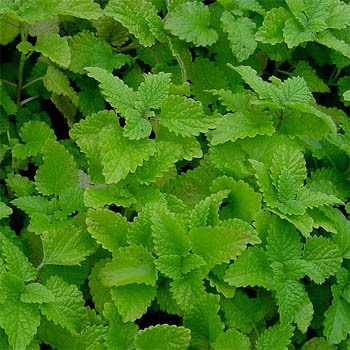New Account | Seed Mix |
Gift Certificates |AAS Winners |
Gardening Products
SEEDS: Unusual | Annuals | Perennials | Vegetables | Herbs | Trees
Lemon Balm Seeds
As a medicinal plant, lemon balm has traditionally been employed against bronchial inflammation, earache, fever, flatulence, headaches, high blood pressure, influenza, mood disorders, palpitations, toothache and vomiting. A tea made from Lemon balm leaves is said to soothe menstrual cramps and helps relieve PMS.
The herb is used for nervous agitation, sleeping problems, functional gastrointestinal complaints, menstrual cramps and urinary spasms.
It is thought that the volatile oils in lemon balm contain chemicals that relax muscles, particularly in the bladder, stomach, and uterus, thereby relieving cramps, gas, and nausea.
Useful gardening information
Growing lemon balm is a warm weather activity. After all danger of frost has past, set lemon balm plants 20 to 24 inches apart in rich soil where it will receive some shade during the day. Lemon balm will remain green during mild winters, such as those in zones 9 and 10. This plant responds well to cutting, growing back twice as thick. Whenever your plant is looking tired due to drought, hail, insects, or other stress, just cut it back and let it rejuvenate itself with fresh, new growth. Lemon balm likes rich, moist, but well-drained soil with a pH of 6 to 7. Because most people harvest it continually for lots of leaves, lemon balm needs a little fertilizer.
When planting, add a coated, slow-release fertilizer such as 20-20-20 at the rate recommended on the label, or work plenty of organic nutrients from compost, blood meal, or cottonseed meal into the soil.

HR105 Lemon Balm ( Melissa officinalis )
An herb everyone should grow. Grown as an annual in cooler zones, as a perennial in zones 9 and above. Lemon scented leaves and sprigs used to make teas and cool
drinks. Good for potpourri and the flowers attract bees.

3689 Quedlingburger Lemon Balm ( Melissa officinalis )
Fresh leaves burst of lemon when squeezed. A truly delightful tea made from the dried leaves is our favorite anytime tea as it both stimulates the heart and calms the nerves. We urge everyone to try it.
Finely chop fresh leaves into salads, white sauce for fish, fruit drinks, mayonnaise, sauerkraut, pasta, fish, chicken, pork, marinades, ice cream and herbal teas. Add to blended vinegars, try this lemon balm with tarragon. Substitute for lemon juice in jam making. Proven effective against herpes.
A strong lemon balm tea is a great substitute for lemon juice in many recipes. Quedlinburger Niederliegende is higher in essential oil content than common lemon balm, and is very productive as well. Lemon balm tea, when sweetened with honey, is used medicinally to help with stress, indigestion, and headaches.
Quedlingburger is a taller variety, up to 24 inches tall. Good oil content at about 0.2 percent. Can be grown as an annual or good outside for zones 5-9.
Finely chop fresh leaves into salads, white sauce for fish, fruit drinks, mayonnaise, sauerkraut, pasta, fish, chicken, pork, marinades, ice cream and herbal teas. Add to blended vinegars, try this lemon balm with tarragon. Substitute for lemon juice in jam making. Proven effective against herpes.
A strong lemon balm tea is a great substitute for lemon juice in many recipes. Quedlinburger Niederliegende is higher in essential oil content than common lemon balm, and is very productive as well. Lemon balm tea, when sweetened with honey, is used medicinally to help with stress, indigestion, and headaches.
Quedlingburger is a taller variety, up to 24 inches tall. Good oil content at about 0.2 percent. Can be grown as an annual or good outside for zones 5-9.
Share a growing tip or recipe and help other gardeners!
Click on the Contact Form link, place "Tip" in the name line and fill in your information. If we accept your Lemon Balm growing tip or recipe, we will post it on this page.
